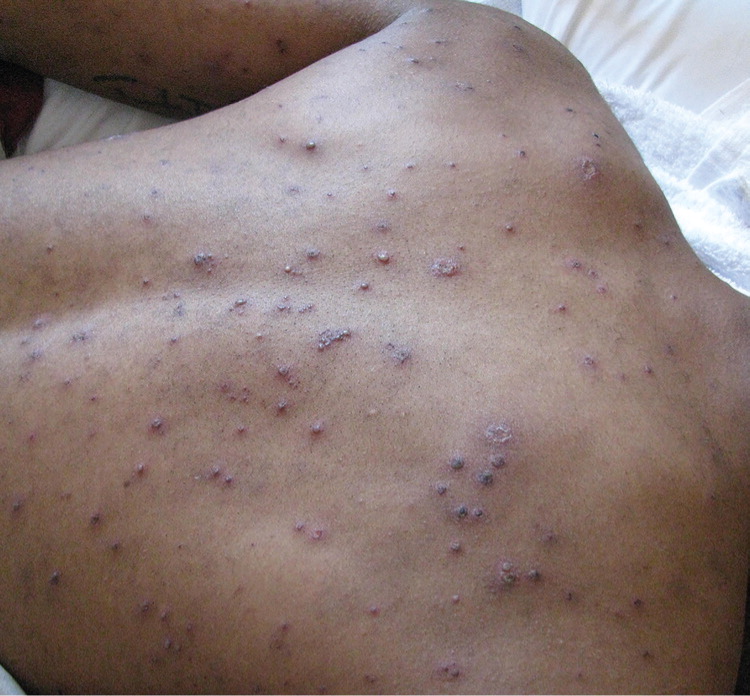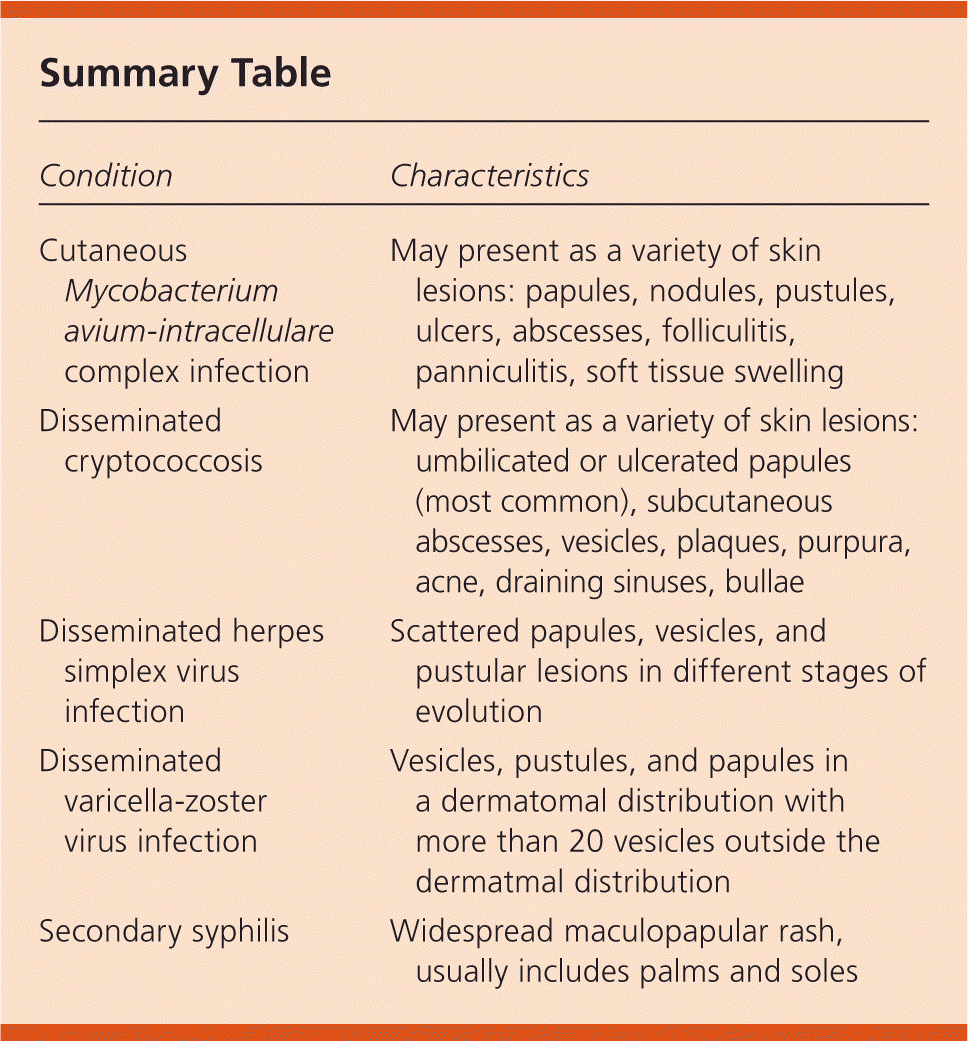
Am Fam Physician. 2016;94(8):658-660
Author disclosure: No relevant financial affiliations.
A 28-year-old man with a history of human immunodeficiency virus (HIV) infection and AIDS presented to the emergency department with fever and a widespread, severely painful, pruritic rash. The cutaneous eruption began on his chest and rapidly spread to his face, left lower eyelid, neck, trunk, genitalia, and upper and lower extremities. His CD4 cell count was 6 per mm3 (0.01 × 109 per L) with a viral load of 768,970 copies per mL. He was not compliant with highly active antiretroviral therapy. His white blood cell count, liver function, and kidney function were normal. He reported having chickenpox as a child.
On examination, he had vesicles and pustules, some umbilicated, overlying an erythematous base in a generalized distribution (Figure 1). His skin was tender, but the mucosal surfaces were unaffected. Ophthalmologic evaluation revealed no intraocular involvement.

Question
Discussion
The answer is D: disseminated varicella-zoster virus infection. A swab of a vesicle base was positive for varicella-zoster virus antigen. Hematoxylin-eosin stain of a skin biopsy revealed classic findings of herpes infection, which may be caused by herpes simplex virus, cytomegalovirus, or varicella virus. These findings include nuclear inclusions (Cowdry bodies) and multinucleation. Skin cultures were negative for bacteria, fungi, and acid-fast bacilli.
Unusual presentations of HIV-associated varicella-zoster virus infection include multidermatomal, ulcerative, verrucous, and disseminated rashes with fulminant visceral involvement.1 Cutaneous dissemination alone is an atypical presentation and is defined as more than 20 vesicles outside a dermatomal distribution.2 Most disseminated cases begin in a dermatomal distribution, then generalize or disseminate to the liver and spleen. The patient presented with widespread vesicles and pustules similar to a primary varicella infection without the visceral involvement that usually occurs with disseminated varicella-zoster virus infection.
Disseminated varicella-zoster virus infection should be considered in patients with HIV infection or AIDS who have a CD4 cell count of less than 500 per mm3 (0.50 × 109 per L).1 Diagnostic workup starts with a detailed history, including previous varicella infection or recent varicella-zoster immunization. Infected epithelial cells from a vesicle base may be sent for rapid diagnosis via a Tzanck test or direct fluorescent antibody test.1 Direct fluorescent antibody testing differentiates herpes simplex virus and varicella-zoster virus infections.3 A skin biopsy may also be obtained for histology and viral culture. Varicella-zoster DNA found in epithelial cells from a vesicle base or scabs from skin lesions can be identified on polymerase chain reaction testing, which is rapid and highly sensitive.3 Polymerase chain reaction testing from other specimens, such as blood or cerebrospinal fluid, is less desirable. Treatment with antivirals is effective if given within 72 hours of the onset of the rash or radicular pain. Treatment should be continued until all skin lesions have scabbed and any organ involvement has resolved.
Although rare, disseminated herpes simplex virus infection can manifest solely as cutaneous involvement, appearing as scattered papules, vesicles, and pustular lesions in different stages of evolution.6 In patients who are immunocompromised, disseminated herpes simplex virus infection usually involves visceral organs. It may present as fulminant hepatitis, encephalitis, or pneumonia.
Secondary syphilis presents four to eight weeks after a primary chancre with widespread macules and papules, usually including the palms and soles.7 It is usually accompanied by fever, malaise, arthralgias, myalgias, pharyngitis, and nontender lymphadenopathy.

| Condition | Characteristics |
|---|---|
| Cutaneous Mycobacterium avium-intracellulare complex infection | May present as a variety of skin lesions: papules, nodules, pustules, ulcers, abscesses, folliculitis, panniculitis, soft tissue swelling |
| Disseminated cryptococcosis | May present as a variety of skin lesions: umbilicated or ulcerated papules (most common), subcutaneous abscesses, vesicles, plaques, purpura, acne, draining sinuses, bullae |
| Disseminated herpes simplex virus infection | Scattered papules, vesicles, and pustular lesions in different stages of evolution |
| Disseminated varicella-zoster virus infection | Vesicles, pustules, and papules in a dermatomal distribution with more than 20 vesicles outside the dermatmal distribution |
| Secondary syphilis | Widespread maculopapular rash, usually includes palms and soles |